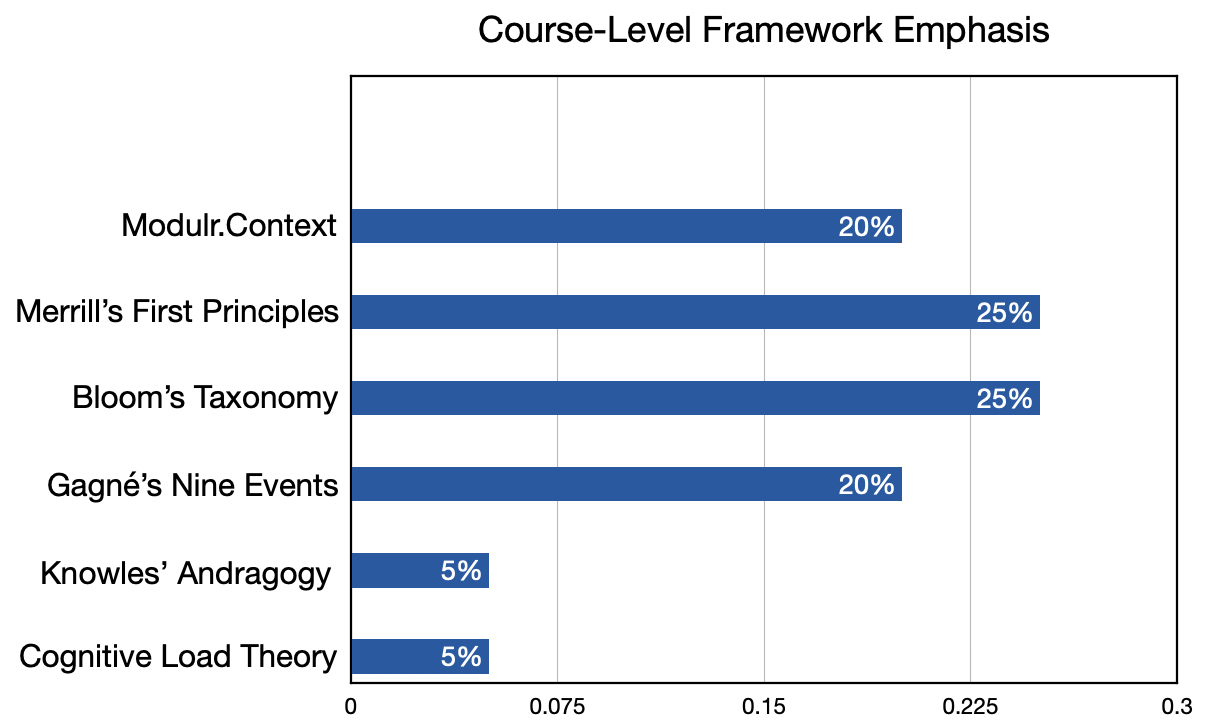Learning Systems That Learn — Visualizing Design Intelligence for Every Course
modulr.blueprint dashboard™
Course
Managing Hazardous Waste in Hospital Operations
Organization
Northside Health Network
Status
Ready
DESIGN RATIONALE — WHAT DID WE PRIORITIZE AND WHY
content priority
Segregation, labeling, and incident response accuracy — core to compliance, safety, and Northside’s audit-readiness goals.
instructional priority
Decision-making under time pressure — mirrors real shift conditions to build reliable judgment.
design constraint
Shift-based, high-turnover staff environment — necessitated microlearning modules and mobile-first access.
design drivers
Behavioral
Time pressure and multitasking increase segregation and labeling errors.
Reporting hesitancy and unclear escalation norms slow incident capture.
technical
Limited access to systems during shifts; training must function offline/mobile.
operational
Frequent float staff and high turnover create inconsistent policy application.
Vendor pickup windows require precise handoff and labeling timing.
design overview
Audience
Frontline clinical and lab staff handling waste during care delivery.
Experience varies from new hires to rotating float staff.
Work context: 500-bed hospital, color-coded bins, cross-coverage handoffs, multiple units, and tight vendor schedules.
Constraints: limited time per task, competing priorities, policy variability across shifts.
content
Mapped content coverage: 100% of required policy and SOP domains.
Core topics: segregation accuracy, labeling and handoff continuity, spill/exposure response, secure storage, and incident reporting.
SME-pending items: color-to-stream mapping, escalation thresholds, PPE and reporting platform specifics.
objectives
Learners will:
Correctly segregate and label hazardous waste.
Respond safely to spills/exposures.
Secure waste storage pending vendor pickup.
Report near-misses promptly.
Objective → Module Mapping:
• Obj 1 → M1 (Segregation), M2 (Labeling)
• Obj 2 → M3 (Spill Response)
• Obj 3 → M4 (Secure Storage)
• Obj 4 → M5 (Reporting)
Context-Drive Instruction™ Insights
-
Module 1 “Segregation Under Pressure” opens with frontline decision under time constraints.
-
Modules 1–2 feature handoff and float nurse dilemmas.
-
Module 4 centers on inspection and reporting behaviors for audit readiness.
-
Module 4 references delayed vendor arrival and overflow management.
-
Module 3 depicts variable PPE availability in spill response scenarios.
-
Module 5 reframes under-reporting into proactive near-miss capture.
Learning Frameworks
Modules 1–2 emphasize Merrill (problem-centered practice) and Bloom (application).
Module 3 heightens Gagné sequence and CLT management through stepwise actions.
Module 4 strengthens Bloom Evaluate for inspection judgment.
Module 5 focuses on Knowles motivation and behavioral reinforcement.
Dominant frameworks are Merrill’s First Principles, Gagné’s Nine Events, and Bloom’s Taxonomy (Apply/Evaluate level).
Supporting frameworks: Knowles’ Andragogy (relevance and habit-building) and Cognitive Load Theory (chunked micro-modules).
Instruction centers on realistic dilemmas, guided reflection, immediate feedback, and accessibility compliance.
How This Course Differs from Generic Training
DESIGN Emphasis
Heavier on contextual realism and decision accuracy situated in the work environment of Northside Health Network and lighter on lecture-style compliance summaries.
Design Insights
Strongest judgment design in M1–M3; scenarios replicate real shift stressors for authentic transfer.
Minor risk: unresolved SME specifics (labeling rules, PPE, escalation) could affect decision fidelity.
Facilitators can use module intros as audit coaching prompts during unit huddles.
Next iteration should finalize job aids (Bin/Label Matrix, Inspection Checklist) and embed recall cues for spaced learning
Module Highlights
M1 – Segregation Under Pressure: Rush-hour mis-segregation scenario; learners decide immediate correction steps.
M2 – Labeling and Handoff Continuity: Unlabeled sharps container case; emphasizes ownership and traceability.
M3 – Spill and Exposure Response: Corridor spill sequence; focuses on containment and escalation timing.
M4 – Daily Inspection and Secure Storage: Corridor staging error; teaches secure area relocation.
M5 – Reporting and Near-Miss Capture: Glove-tear incident; reinforces immediate reporting culture.
Downloads
next steps
Review → Approve → Build → Integrate into LMS.
Option: Request Dashboard Walkthrough for SME artifact alignment.
Team Rating (Pending): ⭐⭐⭐⭐☆
Final feedback summary to be added once implementation is complete.
Metadata and Footer
Generated By: Modulr.Outline v1.4.1
Based On: Modulr.Context v2 and Modulr.AI Behavioral Rules v1.2.5
Compliance Check: ✔ Tier 1 Behavioral Rules
Review Notes: [auto-filled or left blank]
Blueprint Version: 1.0



